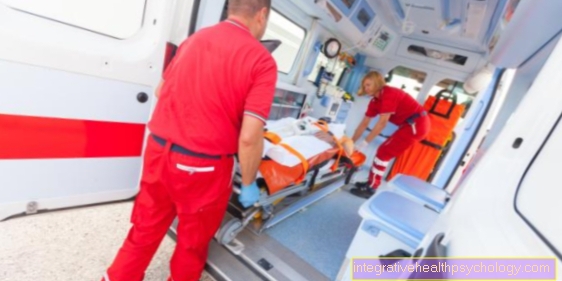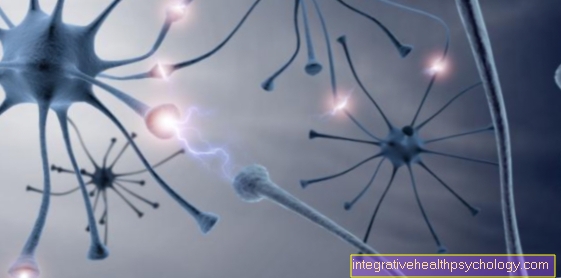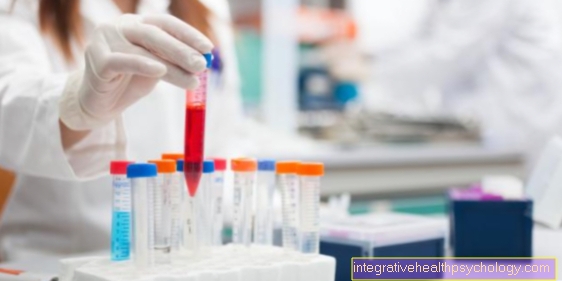Septic shock
definition
A septic shock is a bacterial infection that spreads to the vascular system. In this context, the pathogens distributed in the body lead to impaired blood circulation, which manifests itself in a circulatory disorder. The patient has an increased pulse, decreased blood pressure and fever. The shock is defined by reference values relating to the pulse and blood pressure and indicates the patient's emergency status. If the insufficient supply of the organs resulting from the circulatory disorder cannot be remedied, there is a risk of multiple organ failure.
Read more about the topics:
- Shock index
- Bacteria in the blood - how dangerous is it?
- anaphylactic shock

causes
The cause of septic shock is a bacterial infection that generalizes in the body. A generalized infection is understood as the transfer of bacteria from their actual source of infection into the blood system. The pathogens distributed with the blood flow can reach all organs in this way. The infection is no longer local, but generalized throughout the body.
The trigger for the transfer of the bacteria can be varied. However, a bacterial focus must have existed somewhere in the body in order to cause septic shock. The easiest way to explain the development is using a central venous catheter (CVC). For example, if a patient needs intensive treatment with a constant number of infusions, a central venous catheter is often placed. It enables safe access to the vascular system that can be used for more than a few days. In order for the catheter to be in the blood vessel, the skin and other structures must first be pierced. So there is a connection to the skin surface. The catheter can be used by bacteria from an infected puncture wound as a guide rail and enables them to penetrate the vascular system.
In fact, all surgical interventions or other wounds that injure the skin can, in the worst case, lead to septic shock. Chronic illnesses such as diabetes mellitus or an immune deficiency can also promote the development of septic shock.
Read more on the topic: postoperative complications
The rule of thumb should be that any accumulation of bacteria in the body can lead to inflammation and, if ignored or not treated, can progress until it becomes connected to the vascular system. In this case, the spread can be due to hygienic, therapeutic or immune-related aspects.
Read more on the topic: Causes of shock
pneumonia
A Pneumonia (inflammation of the lungs) can also be a possible trigger of septic shock. Because pneumonia is often one bacterial infection of the lungs through so-called Pneumococci. The bacteria accumulate in the alveoli and cause inflammation, which prevents gas exchange in the lungs. As the inflammation progresses, it is connected to the vascular system via the small vessels that surround the alveoli. If the bacteria, which are distributed with the bloodstream, trigger a severe circulatory disorder with fever, doctors speak of the development of septic shock starting from pneumonia.
diagnosis
The diagnosis of septic shock requires a comprehensive examination, which leads to the initiation of therapy as soon as possible. The cornerstone of every medical examination - the anamnesis - usually cannot be carried out in the event of septic shock due to the patient's circulatory situation. In the case of unconscious people, objective parameters such as this apply Respiratory rate, the Pulse, the Blood pressure and the temperature focus and stabilize it if necessary. If the patient is conscious or if an accompanying person is present, an anamnesis can provide further clarification. Additionally be Blood samples taken and the Physically examined patientin order to narrow down the cause more precisely. If the laboratory values are available, they are through imaging such as, for example X-rays or a CT added. The diagnosis “septic shock” is then based on the synopsis of the present Vital parameters, the Inflammation values in the blood and the physical exam posed.
Concomitant symptoms
A septic shock is often accompanied by symptoms, which can usually be explained by the circulatory disorder. The body there is basically a lack of fluid in this shock state. As a result, the heart is no longer supplied with enough blood volume to pump into the circulation. Over a increased heart rate it tries to compensate for this deficiency, which the patient finds uncomfortable Racing heart feels. The lack of volume manifests itself subjectively for the person concerned in Weakness and dizzinessbecause, in addition to all organs and tissues, the brain is also insufficiently supplied with blood and nutrients.
This deficiency becomes threatening when the person concerned begins black spots or blurred vision. This indicates an approaching Circulatory collapse without any intervention in a Faint will show. If the circulatory disorder becomes more acute, the sympathetic system is also activated in the context of this stressful situation. The consequence is a cold sweatingthat originally in combat situations should cool the body. In the context of a state of shock it manifests itself as a massive onset of sweating. This sweating differs from the sweating that is caused by a fever. Those affected notice this in spurts with a feeling of heat in the feverish phases.
Treatment / therapy
Treatment of septic shock must be as two-phase be seen. If a patient is in septic shock, he is in one Emergency condition. Most of the time, the patients are no longer able to speak intelligibly or are unconscious due to their poor circulation. For the First aid this means breathing as quickly as possible, if needed to secure and the To stabilize circulation. This succeeds both through an appropriate Shock positioning and the Supply of liquid via a venous access. Depending on the measured blood pressure and pulse, the Administration of catecholamines such as adrenaline may also be necessary. If the patient is stabilized enough that he is transportable, is a Treatment in the intensive care unit is essential.
If the patient has a stable circulation, the second phase of treatment follows. It still applies To continuously monitor the patient's vital parameters via a monitor, but now the Search for the cause additionally in focus. The trigger of the shock state should be done using Blood tests and imaging can be found out and give a statement about the severity of the infection. Once the bacterial infection has been found and interpreted using laboratory parameters, it is determined using Antibiotics treated. A pathogen detection carried out beforehand ensures the effectiveness of the antibiotic.
storage
The storage during a septic shock corresponds to the actual one Shock positioningwhich should be carried out by first responders until further help occurs. The person concerned must lie on your back, So that the Legs raised about 30 ° can be. In the best case, this is Upper body also slightly raised. Storage achieves that Blood flows from the legs towards the heart and thus enough volume is available again for the cycle. In most cases, the lack of fluids is the reason why the affected person is in shock. Finding and knowing about the person affected also determines the correct positioning. If you feel sick or vomit, you should lie on your side in a stable position as well as finding an unconscious stranger. It is therefore important to weigh up how to store in each individual case, with every help bringing an improvement.
Duration
The duration of a septic shock can vary greatly in individual cases. Basically, however, a state of shock is very important must be treated quicklybecause otherwise can be fatal. With adequate treatment, a state of shock should not last longer than several hours. But it only means that the patient's circulation is stabilized by therapeutic measures. This means that he can still be in a life-threatening condition, but by definition no longer in shock (shock index: pulse / systolic blood pressure, shock => 1). Relapse would be expected if medication or treatment were discontinued. In the most severe cases, however, a shock can last for several days.
Prognosis / chances of survival
The prognosis of septic shock depends on many factors and should always be assessed carefully. Epidemiological die about 60% of those affected despite intensive medical therapy. Especially the The number and virulence of the pathogen decide about how fast the response to therapy and thus an improvement will be. In this context, virulence describes the ability of bacteria to trigger a disease. But it always has to go with the Resistance of bacteria to antibiotics be seen. Multi-resistance is to be seen as a more unfavorable prognosis. In addition to the pathogen-related aspects, there is also the General condition of the patient is decisive. Depending on the body's defenses and reserves of the person affected, the therapy works more or less well. In general, the prognosis depends on the onset of therapy. The earlier treatment is started, the better the chances of recovery. The longer the shock persists, the higher the risk of deterioration or permanent damage.
consequences
The consequences of septic shock depend on the duration and extent of the shock. The longer the blood circulation in the organs was interrupted, the greater the damage. The brain is that most sensitive organ and is the first to react to an undersupply. The consequences of a temporary shortage of supply can vary greatly and be short-term Speech disorders to states of confusion pass. If the blood supply has been severely interrupted, so are motor failures conceivable. No less dangerous are the damage caused by Blood clots in the organs can arise themselves. If the blood no longer circulates in the vessels, it coagulates and clogs the vessels. The lack of blood supply can turn a Tissue death behind the closure result in what is in a decreased function of the affected organ can express. If blood clots are stuck in the vessels in several organs, this can develop Multiple organ failure develop. If the blood clots are washed away with the restored blood flow, the Development of a pulmonary embolism threaten. It is important to know that not only the septic shock itself has consequences, but also its therapy. The Use of antibiotics -which is essential- can also Side effects to have. For example, they are not uncommon harmful to the kidneys. In summary, one can say that the consequences of a septic shock can be diverse and definitely require further follow-up treatment and medical control.

















.jpg)











